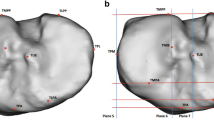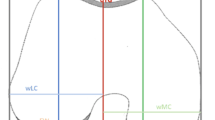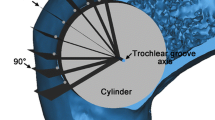Abstract
Purpose
The authors hypothesise that the trochlear dysplastic distal femur is not only characterised by morphological changes to the trochlea. The purpose of this study is to describe the morphological characteristics of the trochlear dysplastic femur in and outside the trochlear region with a landmark-based 3D analysis.
Methods
Arthro-CT scans of 20 trochlear dysplastic and 20 normal knees were used to generate 3D models including the cartilage. To rule out size differences, a set of landmarks were defined on the distal femur to isotropically scale the 3D models to a standard size. A predefined series of landmark-based reference planes were applied on the distal femur. With these landmarks and reference planes, a series of previously described characteristics associated with trochlear dysplasia as well as a series of morphometric characteristics were measured.
Results
For the previously described characteristics, the analysis replicated highly significant differences between trochlear dysplastic and normal knees. Furthermore, the analysis showed that, when knee size is taken into account, the cut-off values of the trochlear bump and depth would be 1 mm larger in the largest knees compared to the smallest knees. For the morphometric characteristics, the analysis revealed that the trochlear dysplastic femur is also characterised by a 10 % smaller intercondylar notch, 6–8 % larger posterior condyles (lateral–medial) in the anteroposterior direction and a 6 % larger medial condyle in the proximodistal direction compared to a normal femur.
Conclusions
This study shows that knee size is important in the application of absolute metric cut-off values and that the posterior femur also shows a significantly different morphology.




Similar content being viewed by others
Notes
Because the CT scan only captured the knee joint, the longitudinal axis of the femur was estimated by drawing 2 circles on a sagittal view through the shaft of the femur as described by Biedert et al. [6].
Abbreviations
- TD group:
-
Trochlear dysplastic group
- AP:
-
Anteroposterior
- PD:
-
Proximodistal
- ML:
-
Mediolateral
- sTEA:
-
Surgical transepicondylar axis
- PCL:
-
Posterior condylar line
- ACL:
-
Anterior cruciate ligament
- FME:
-
Femoral medial epicondyle
- FMS:
-
Femoral medial sulcus
- FLE:
-
Femoral lateral epicondyle
- FMCP:
-
Femoral medial condyle posterior
- FLCP:
-
Femoral lateral condyle posterior
- FMCD:
-
Femoral medial condyle distal
- FLCD:
-
Femoral lateral condyle distal
- FMTA:
-
Femoral medial trochlea anterior
- FLTA:
-
Femoral lateral trochlea anterior
- FMCPP:
-
Femoral medial condyle posterior proximal
- FLCPP:
-
Femoral lateral condyle posterior proximal
- PE:
-
Proximal edge of the trochlea cartilage
- FMCIP:
-
Femoral medial condyle internal point
- FMCEP:
-
Femoral medial condyle external point
- FLCIP:
-
Femoral lateral condyle internal point
- FLCEP:
-
Femoral lateral condyle external point
- PL:
-
Patella lateral point
- PM:
-
Patella medial point
- PS:
-
Patella superior point
- PI:
-
Patella inferior point
References
Allen BC, Peters CL, Brown NAT, Anderson AE (2010) Acetabular cartilage thickness: accuracy of three-dimensional reconstructions from multidetector CT Arthrograms in a cadaver study. Radiology 255(2):544–552
Anderson AF, Lipscomb AB, Liudahl KJ, Addlestone RB (1987) Analysis of the intercondylar notch by computed-tomography. Am J Sport Med 15(6):547–552
Bellemans J, Carpentier K, Vandenneucker H, Vanlauwe J, Victor J (2010) The John Insall Award: both morphotype and gender influence the shape of the knee in patients undergoing TKA. Clin Orthop Relat Res 468:29–36
Biedert R, Sigg A, Gal I, Gerber H (2011) 3D representation of the surface topography of normal and dysplastic trochlea using MRI. Knee 18(5):340–346
Biedert RM, Bachmann M (2009) Anterior-posterior trochlear measurements of normal and dysplastic trochlea by axial magnetic resonance imaging. Knee Surg Sports Traumatol Arthrosc 17(10):1225–1230
Biedert RM, Netzer P, Gal I, Sigg A, Tscholl PM (2011) The lateral condyle index: a new index for assessing the length of the lateral articular trochlea as predisposing factor for patellar instability. Int Orthop 35(9):1327–1331
Bredbenner TL, Eliason TD, Potter RS, Mason RL, Havill LM, Nicolella DP (2010) Statistical shape modeling describes variation in tibia and femur surface geometry between control and incidence groups from the osteoarthritis initiative database. J Biomech 43(9):1780–1786
Caton J, Deschamps G, Chambat P, Lerat JL, Dejour H (1982) The low patellas—report of 128 cases—patella-inferae. Rev Chir Orthop 68(5):317–325
Chhabra A, Subhawong TK, Carrino JA (2011) A systematised MRI approach to evaluating the patellofemoral joint. Skeletal Radiol 40(4):375–387
Dejour D, Byn P, Ntagiopoulos PG (2013) The Lyon’s sulcus-deepening trochleoplasty in previous unsuccessful patellofemoral surgery. Int Orthop 37(3):433–439
Dejour D, Le Coultre B (2007) Osteotomies in patello-femoral instabilities. Sports Med Arthrosc 15(1):39–46
Dejour D, Reynaud P, Lecoultre B (1998) Douleurs et instabilité rotulienne. Essai de classification. Méd Hyg 56:1466–1471
DeJour D, Saggin P (2010) The sulcus deepening trochleoplasty—the Lyon’s procedure. Int Orthop 34(2):311–316
Dejour H, Walch G, Nove-Josserand L, Guier C (1994) Factors of patellar instability: an anatomic radiographic study. Knee Surg Sports Traumatol Arthrosc 2(1):19–26
Endo Y, Schweitzer ME, Bordalo-Rodrigues M, Rokito AS, Babb JS (2007) MRI quantitative morphologic analysis of patellofemoral region: lack of correlation with chondromalacia patellae at surgery. Am J Roentgenol 189(5):1165–1168
Fitzpatrick CK, Baldwin MA, Laz PJ, FitzPatrick DP, Lerner AL, Rullkoetter PJ (2011) Development of a statistical shape model of the patellofemoral joint for investigating relationships between shape and function. J Biomech 44(13):2446–2452
Fucentese SF, Zingg PO, Schmitt J, Pfirrmann CW, Meyer DC, Koch PP (2011) Classification of trochlear dysplasia as predictor of clinical outcome after trochleoplasty. Knee Surg Sports Traumatol Arthrosc 19(10):1655–1661
Goodall C (1991) Procrustes methods in the statistical-analysis of shape. J R Stat Soc B 53(2):285–339
Gower JC (1975) Generalized procrustes analysis. Psychometrika 40(1):33–51
Grelsamer RP, Bazos AN, Proctor CS (1993) Radiographic analysis of patellar tilt. J Bone Jt Surg Br 75(5):822–824
LaPrade RE, Engebretsen AH, Ly TV, Johansen S, Wentorf FA, Engebretsen L (2007) The anatomy of the medial part of the knee. J Bone Jt Surg Am 89A(9):2000–2010
LaPrade RF, Ly TV, Wentorf FA, Engebretsen L (2003) The posterolateral attachments of the knee—a qualitative and quantitative morphologic analysis of the fibular collateral ligament, popliteus tendon, popliteofibular ligament, and lateral gastrocnemius tendon. Am J Sport Med 31(6):854–860
Laurin CA, Levesque HP, Dussault R, Labelle H, Peides JP (1978) Abnormal lateral patello-femoral angle—diagnostic roentgenographic sign of recurrent patellar subluxation. J Bone Jt Surg Am 60(1):55–60
Lippacher S, Dejour D, Elsharkawi M, Dornacher D, Ring C, Dreyhaupt J, Reichel H, Nelitz M (2012) Observer agreement on the Dejour trochlear dysplasia classification. A comparison of true lateral radiographs and axial magnetic resonance images. Am J Sport Med 40(4):837–843
Merchant AC, Mercer RL, Jacobsen RH, Cool CR (1974) Roentgenographic analysis of patellofemoral congruence. J Bone Jt Surg Am A 56(7):1391–1396
Myronenko A, Song XB (2010) Point set registration: coherent point drift. IEEE T Pattern Anal 32(12):2262–2275
Nelitz M, Lippacher S, Reichel H, Dornacher D (2013) Evaluation of trochlear dysplasia using MRI: correlation between the classification system of Dejour and objective parameters of trochlear dysplasia. Knee Surg Sports Traumatol Arthrosc. doi:10.1007/s00167-012-2321-y
Pfirrmann CWA, Zanetti M, Romero J, Hodler J (2000) Femoral trochlear dysplasia: MR findings. Radiology 216(3):858–864
Remy F, Chantelot C, Fontaine C, Demondion X, Migaud H, Gougeon F (1998) Inter- and intraobserver reproducibility in radiographic diagnosis and classification of femoral trochlear dysplasia. Surg Radiol Anat 20(4):285–289
Remy F, Gougeon F, Eddine TA, Migaud H, Fontaine C, Duquennoy A (2002) Reproducibility of the new classification of femoral trochlea dysplasia proposed by Dejour: predictive value for severity of femoropatellar instability in 47 knees. J Bone Jt Surg Br 84:1
Sasaki T, Yagi T (1986) Subluxation of the patella—investigation by computerized-tomography. Int Orthop 10(2):115–120
Shepstone L, Rogers J, Kirwan JR, Silverman BW (2001) Shape of the intercondylar notch of the human femur: a comparison of osteoarthritic and non-osteoarthritic bones from a skeletal sample. Ann Rheum Dis 60(10):968–973
Shih YF, Bull AM, Amis AA (2004) The cartilaginous and osseous geometry of the femoral trochlear groove. Knee Surg Sports Traumatol Arthrosc 12(4):300–306
Sonnery-Cottet B, Archbold P, Cucurulo T, Fayard JM, Bortolletto J, Thaunat M, Prost T, Chambat P (2011) The influence of the tibial slope and the size of the intercondylar notch on rupture of the anterior cruciate ligament. J Bone Jt Surg Br 93B(11):1475–1478
Staubli HU, Durrenmatt U, Porcellini B, Rauschning W (1999) Anatomy and surface geometry of the patellofemoral joint in the axial plane. J Bone Jt Surg Br 81B(3):452–458
Stefanik JJ, Roemer FW, Zumwalt AC, Zhu YY, Gross KD, Lynch JA, Frey-Law LA, Lewis CE, Guermazi A, Powers CM, Felson DT (2012) Association between measures of trochlear morphology and structural features of patellofemoral joint osteoarthritis on MRI: the MOST study. J Orthopaed Res 30(1):1–8
Toms AP, Cahir J, Swift L, Donell ST (2009) Imaging the femoral sulcus with ultrasound, CT, and MRI: reliability and generalizability in patients with patellar instability. Skeletal Radiol 38(4):329–338
van Huyssteen AL, Hendrix MRG, Barnett AJ, Wakeley CJ, Eldridge JDJ (2006) Cartilage-bone mismatch in the dysplastic trochlea—an MRI study. J Bone Jt Surg Br 88B(5):688–691
Victor J, Van Doninck D, Labey L, Innocenti B, Parizel PM, Bellemans J (2009) How precise can bony landmarks be determined on a CT scan of the knee? Knee 16(5):358–365
Victor J, Wong P, Witvrouw E, Sloten JV, Bellemans J (2009) How isometric are the medial patellofemoral, superficial medial collateral, and lateral collateral ligaments of the knee? Am J Sports Med 37(10):2028–2036
Yamada Y, Toritsuka Y, Yoshikawa H, Sugamoto K, Horibe S, Shino K (2007) Morphological analysis of the femoral trochlea in patients with recurrent dislocation of the patella using three-dimensional computer models. J Bone Jt Surg Br 89B(6):746–751
Acknowledgments
This work was funded by a Research fund of University College Ghent.
Ethical standard
The authors confirm that the study has been approved by the ethics committee and has been performed in accordance with the ethical standards laid down in the 1964 Declaration of Helsinki and its later amendments. All persons gave their informed consent prior to their inclusion in the study.
Conflict of interest
The authors declare that they have no conflict of interest.
Author information
Authors and Affiliations
Corresponding author
Appendix
Appendix
Landmarks femur for rescaling
-
Femoral medial epicondyle (FME): the most anterior and distal osseous prominence over the medial aspect of the medial femoral condyle [21, 39, 40]
-
Femoral medial sulcus (FMS): depression on the bony surface slightly proximal and posterior to FME [21, 39]
-
Femoral lateral epicondyle (FLE): the most anterior and distal osseous prominence over the lateral aspect of the lateral femoral condyle [22, 39]
-
Femoral medial condyle posterior (FMCP): the most posterior point of the medial condyle on the 3D model of the femur, aligned along the longitudinal axis of the femur
-
Femoral lateral condyle posterior (FLCP): the most posterior point of the lateral condyle on the 3D model of the femur, aligned along the longitudinal axis of the femurFootnote 1
-
Femoral medial condyle distal (FMCD): the most distal point of the medial condyle on the 3D model of the femur, aligned along the longitudinal axis of the femur
-
Femoral lateral condyle distal (FLCD): the most distal point of the lateral condyle on the 3D model of the femur, aligned along the longitudinal axis of the femur
-
Femoral medial trochlea anterior (FMTA): the most anterior point of the medial trochlea on the 3D model of the femur, aligned along the longitudinal axis of the femur
-
Femoral lateral trochlea anterior (FLTA): the most anterior point of the lateral trochlea on the 3D model of the femur, aligned along the longitudinal axis of the femur
-
Femoral medial condyle posterior proximal (FMCPP): the most proximal point of the cartilage on the posterior medial condyle, aligned along the longitudinal axis of the femur
-
Femoral lateral condyle posterior proximal (FLCPP): the most proximal point of the cartilage on the posterior lateral condyle, aligned along the longitudinal axis of the femur
-
Notch: the most anterior point in the middle of the femoral notch on a caudal to cranial view of the femur, aligned along the longitudinal axis of the femur.
Additional landmarks
Femur
-
Deepest point on the trochlea along a plane subtended 15° from the perpendicular to the tangent of the posterior femoral cortex [14]
-
Highest point on the trochlea along a plane subtended 15° from the perpendicular to the tangent of the posterior femoral cortex [14]
-
Proximal edge of the trochlea cartilage (PE) [41]
-
Femoral medial condyle internal point (FMCIP): most lateral point of the cartilage of the medial condyle in the axial view of the notch
-
Femoral medial condyle external point (FMCEP): most medial point of the cartilage of the medial condyle in the axial view of the notch
-
Femoral lateral condyle internal point (FLCIP): most medial point of the cartilage of the lateral condyle in the axial view of the notch
-
Femoral lateral condyle external point (FLCEP): most lateral point of the cartilage of the lateral condyle in the axial view of the notch
-
Femoral lateral trochlea: the most anterior point of the lateral trochlea in the axial slice of the femoral lateral condyle posterior
-
Femoral medial trochlea: the most anterior point of the medial trochlea in the axial slice of the femoral lateral condyle posterior
-
Trochlear deepest point: the deepest point of the trochlea in the axial slice of the femoral lateral condyle posterior
-
Trochlear most prominent point: most prominent point of the trochlear groove.
Patella
-
Patella lateral point (PL): most lateral point of the articular surface of the patella
-
Patella medial point (PM): most medial point of the articular surface of the patella
-
Patella superior point (PS): most superior point of the articular surface of the patella
-
Patella inferior point (PI): most inferior point of the articular surface of the patella
-
Patella ridge: point on the border of the medial and lateral facet of the patella.
Tibia
-
Tuberositas tibiae
-
Most anterior point of the tibial articulating surface of the tibia.
Reference planes
-
Plane 1: anterior sTEA plane: plane tangent to the anterior cortex, parallel to the surgical transepicondylar axis (OF: plane parallel to the surgical transepicondylar axis, parallel to FAAx and through the anterior cortex)
-
Plane 2: posterior sTEA plane: plane tangent to the posterior cortex, parallel to the surgical transepicondylar axis (OF: plane parallel to the surgical transepicondylar axis, parallel to FAAx and through the posterior cortex)
-
Plane 3: PCL plane: plane through FMCP and FLCP and parallel to FAAx
-
Plane 4: distal condylar plane: plane through FMCD and FLCD and perpendicular to FAAx
-
Plane 5: proximal condylar plane: plane through FMCPP and FLCPP and perpendicular to FAAx
-
Plane 6: medial plane: plane through FME, parallel to FAAx and perpendicular to PCL
-
Plane 7: notch plane: plane through the notch, parallel to FAAx and perpendicular to PCL
-
Plane 8: lateral plane: plane through FLE, parallel to FAAx and perpendicular to PCL
-
Plane 9: internal medial condyle plane: plane through FMCIP, parallel to FAAx and perpendicular to PCL
-
Plane 10: external medial condyle plane: plane through FMCEP, parallel to FAAx and perpendicular to PCL
-
Plane 11: internal lateral condyle plane: plane through FLCIP, parallel to FAAx and perpendicular to PCL
-
Plane 12: external lateral condyle plane: plane through FLCEP, parallel to FAAx and perpendicular to PCL
-
Plane 13: trochlear depth plane: plane subtended 15° from the perpendicular to the tangent of the posterior femoral cortex to measure the trochlear depth as defined by Dejour et al. [14].
Measurements
Characteristics of trochlear dysplasia
-
Trochlear depth (mm): distance between the highest and deepest point of the trochlea measured perpendicular to plane 3
-
Sulcus angle (°): the angle formed by the intersection of the medial and lateral trochlear facets measured in the axial slice of FLCP
-
Lateral inclination angle of the trochlea (°): the angle between the posterior condylar line and a line along the lateral facet measured in the axial slice of FLCP
-
Medial inclination angle of the trochlea (°): the angle between the posterior condylar line and a line along the medial facet measured in the axial slice of FLCP
-
Trochlear bump (mm): the distance between plane 1 and the most prominent point of the trochlear groove
-
Trochlear cartilage height (mm): the distance between plane 4 and PE
-
Caton-Deschamps index (−): the ratio of the distance between PI and most anterior point of the tibial articulating surface to the length of the articular surface of the patella
-
Lateral patellar displacement (mm): the distance from PM to the perpendicular to plane 3, passing through the most anterior point of the medial condyle
-
Patellar tilt (°): the angle between the patellar width line (line between PL and PM) and PCL
-
Asymmetry trochlear facets (%): percentage of the medial to the lateral trochlear facet length (medial facet/lateral facet × 100)
-
Asymmetry patellar facets (%): percentage of the medial to the lateral patellar facet length (medial facet/lateral facet length × 100).
Morphometric characteristics
-
Medial femur: distance between the FMTA and plane 3
-
Medial trochlea: distance between FMTA and plane 1
-
Medial posterior condyle: distance between the FMCP and plane 2
-
Lateral femur: distance between FLTA and plane 3
-
Lateral trochlea: distance between FLTA and plane 1
-
Lateral posterior condyle: distance between FLCP condyle and plane 2
-
Medial condyle: distance between FMCPP and plane 4
-
Lateral condyle: distance between FLCPP and plane 4
-
Distal femur: distance between FLE and plane 6
-
Medial condyle: distance between FMCIP and plane 10
-
Lateral condyle: distance between FLCIP and plane 12
-
Notch width: distance between FMCIP and plane 11.
Rights and permissions
About this article
Cite this article
Van Haver, A., De Roo, K., De Beule, M. et al. Semi-automated landmark-based 3D analysis reveals new morphometric characteristics in the trochlear dysplastic femur. Knee Surg Sports Traumatol Arthrosc 22, 2698–2708 (2014). https://doi.org/10.1007/s00167-013-2573-1
Received:
Accepted:
Published:
Issue Date:
DOI: https://doi.org/10.1007/s00167-013-2573-1




